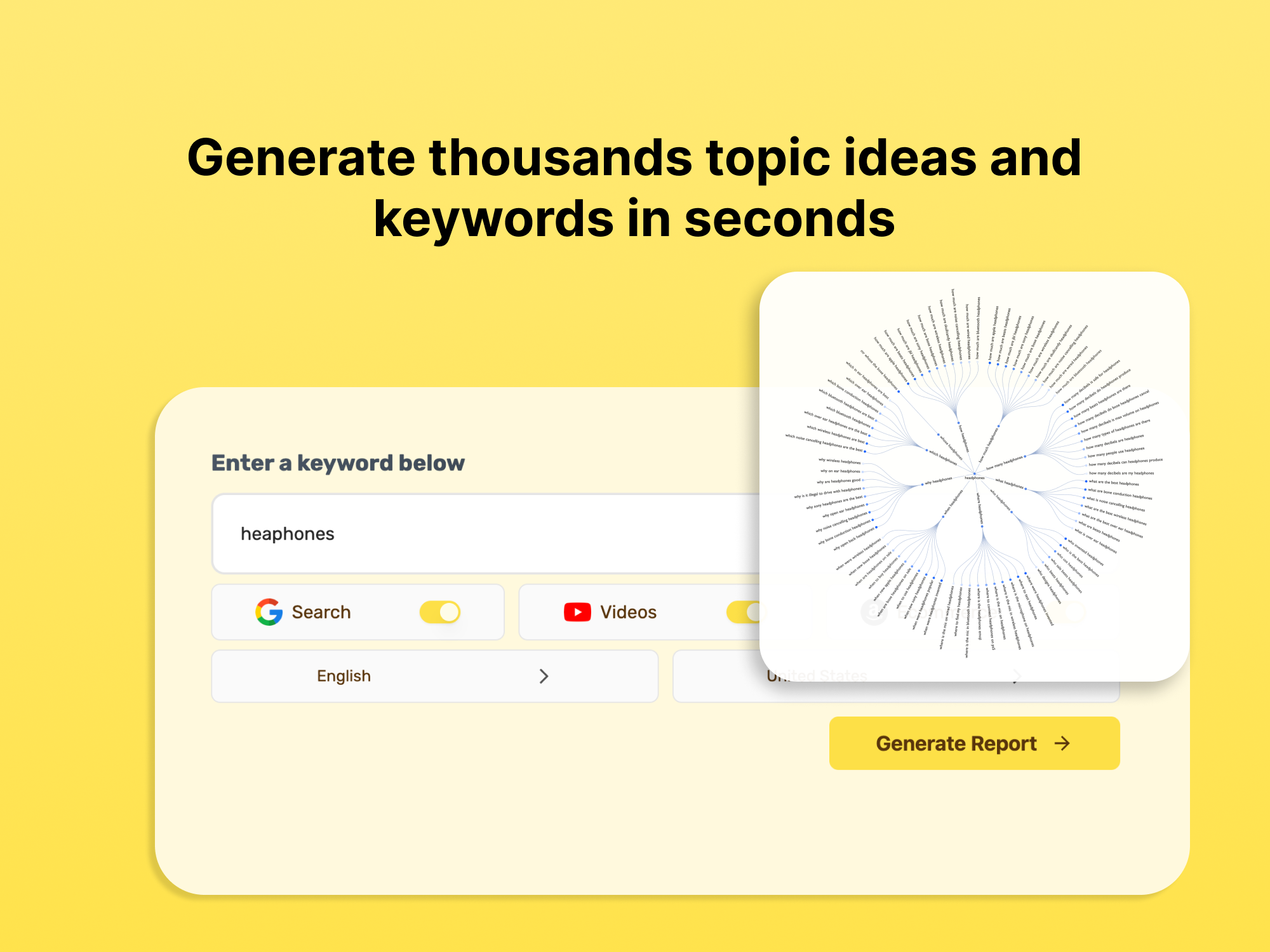
How to Use Search Insights to Improve Website Traffic
Unlock the Power of Search Data to Boost Your Website's Performance
By Shishir
Published on
10 minutes
Table of Contents
Search insights are a powerful resource for understanding user behavior, optimizing your online presence, and driving more traffic to your website. By leveraging data from search engines, analytics tools, and competitive analysis, you can align your content strategy with the needs of your audience and achieve sustained growth in website traffic. This guide will walk you through the key strategies, tools, and actionable steps to harness search insights effectively.
What Are Search Insights?
Search insights are data-driven observations about user behavior on search engines. These insights include information about:
- Keywords: The phrases people use to find information online.
- Search Intent: The underlying purpose behind a search query (e.g., informational, navigational, or transactional).
- Trends: Shifting search patterns over time.
- Competitor Analysis: What’s working for your competitors in terms of SEO and content.
Understanding these elements helps you create content, optimize your site, and structure campaigns that meet user needs, resulting in increased traffic and conversions.
Conduct Comprehensive Keyword Research

Keyword research is the foundation of any successful SEO strategy. It helps you identify the terms and phrases your target audience is searching for.
Tools to Use:
- SearchLens: Create profound keyword discovery reports and find trending topics for content creation.
- Google Keyword Planner: Find keyword ideas and assess search volume and competition.
- SEMrush/Ahrefs: Uncover related keywords, long-tail variations, and keyword difficulty.
- AnswerThePublic: Discover questions and phrases that highlight user intent.
Steps to Take:
- Start Broad: Identify core topics related to your industry. For example, if you run a fitness blog, topics like "home workouts" and "nutrition" are broad starting points.
- Expand to Long-Tail Keywords: Use tools to find specific phrases like "best 15-minute home workout for beginners." Long-tail keywords often have less competition and higher conversion potential.
- Analyze Search Intent: Group keywords based on the user’s goal, such as researching a topic, comparing products, or making a purchase.
Pro Tip: Targeting a mix of high-volume and low-competition keywords can help you build authority in your niche and attract more traffic.
Optimize Your Website for On-Page SEO
On-page SEO ensures your website’s content and structure are optimized for both search engines and users. Incorporating search insights here can greatly improve traffic.
Key Actions:
-
Update Title Tags and Meta Descriptions:
- Include primary keywords naturally.
- Write compelling descriptions to increase click-through rates (CTR).
-
Use Heading Tags Effectively:
- Structure your content with clear H1, H2, and H3 tags.
- Use keywords in headings to improve relevance.
-
Internal Linking:
- Link to related content within your website to improve navigation and encourage users to stay longer.
-
Optimize for Featured Snippets:
- Use bullet points, numbered lists, and concise answers to increase the chances of appearing in snippet boxes on Google.

Example:
A blog post targeting the keyword "how to improve posture" might use:
- H1: "How to Improve Your Posture: Expert Tips and Exercises"
- H2: "Why Good Posture Matters"
- H2: "Simple Posture Exercises You Can Do at Home"
Leverage Content Marketing
Content marketing is a natural extension of search insights. By creating valuable, keyword-rich content, you can attract and retain users while improving your search rankings.
Content Types to Focus On:
- Blog Posts:
- Create in-depth guides, how-tos, and listicles that address user questions.
- Use tools like BuzzSumo to find trending topics in your niche.
- Video Content:
- Leverage platforms like YouTube to drive traffic. Optimize titles and descriptions with keywords.
- Repurpose blog posts into videos to expand reach.
- Infographics:
- Visualize complex data to make it shareable and engaging.
- FAQs:
- Answer common questions to target featured snippets and voice search results.
Steps to Align Content with Search Insights:
- Map Keywords to Content: Assign specific keywords to each page or blog post to avoid overlap and maximize relevance.
- Analyze Performance: Use Google Analytics to identify which content drives the most traffic and optimize underperforming pieces.
- Update Old Content: Refresh outdated posts with current data, new keywords, and updated links.

Utilize Search Trends to Stay Ahead
Search trends reveal what topics are gaining popularity over time. Staying ahead of these trends can help you create timely, relevant content that drives spikes in traffic.
Tools to Use:
- Google Trends: Monitor rising search terms and seasonal patterns.
- Exploding Topics: Discover fast-growing trends in your industry.
Steps to Take:
- Identify Seasonal Opportunities: For instance, a retailer can target "back-to-school supplies" in the months leading up to the school year.
- Create Evergreen Content with a Timely Twist: Write about ongoing trends while ensuring the content remains valuable long-term.
- Adapt Quickly: Use insights to pivot content or product strategies based on user interests.
Perform Competitor Analysis

Analyzing your competitors’ strategies provides a blueprint for success while helping you uncover missed opportunities.
Key Insights to Gather:
- Top-Ranking Keywords: Identify the keywords competitors rank for and replicate their success.
- Content Gaps: Look for topics your competitors haven’t covered but are relevant to your audience.
- Backlink Opportunities: Use tools like Ahrefs or SEMrush to find high-authority sites linking to competitors and pitch your content.
Steps to Take:
- SpyFu: Use SpyFu to analyze your competitors' PPC and organic strategies.
- Ahrefs: Discover competitor content that earns the most backlinks.
- Benchmark Performance: Compare traffic, engagement metrics, and domain authority to identify areas for improvement.
Optimize for Mobile and Local Search
With most searches happening on mobile devices, optimizing for mobile and local SEO is critical.
Mobile Optimization Tips:
- Ensure your site is mobile-friendly with responsive design.
- Optimize page load times to reduce bounce rates.
Local Search Strategies:
- Google My Business: Claim and optimize your listing to appear in local search results.
- Location-Specific Keywords: Target keywords like "best pizza in New York City."
- Encourage Reviews: Positive reviews on platforms like Yelp can improve rankings and attract local traffic.
Monitor and Adapt with Analytics
Tracking your performance is key to understanding what works and what doesn’t. Regularly analyze your data to refine your strategies.

Tools to Use:
- Google Analytics: Measure traffic, bounce rates, and conversion metrics.
- Google Search Console: Monitor search performance, index status, and keyword rankings.
Steps to Take:
- Set KPIs: Define metrics like organic traffic, CTR, and conversion rates to measure success.
- Regular Reporting: Review analytics monthly to identify trends and adjust strategies.
- A/B Testing: Experiment with changes to content, CTAs, or page layouts to optimize performance.
Conclusion
Search insights are the key to unlocking sustained website traffic growth. By understanding what users are searching for and aligning your website’s content and structure to meet their needs, you can attract more visitors and achieve your goals. From keyword research and content creation to competitor analysis and mobile optimization, leveraging search insights ensures you stay ahead in a competitive digital landscape. Start implementing these strategies today to see tangible results in your website traffic.